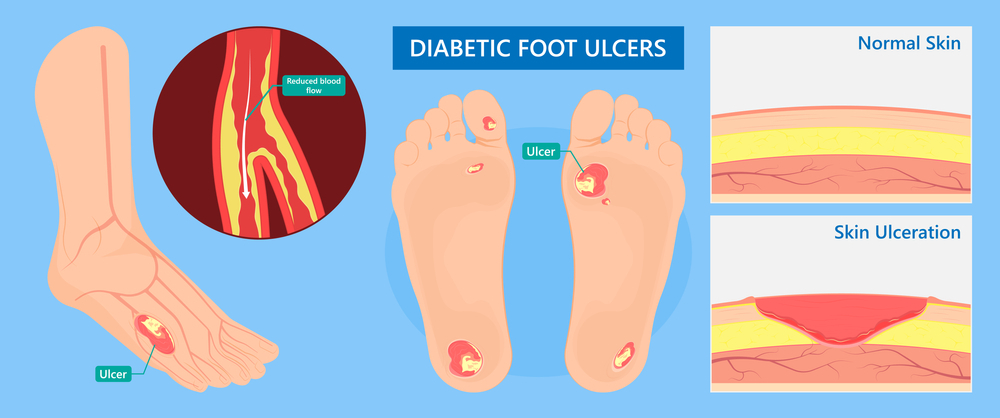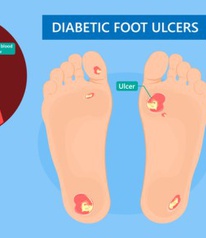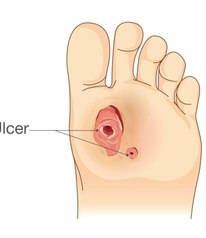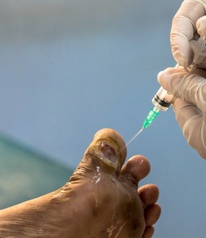
A leg ulcer, as we all know, is a common affliction affecting the legs or feet in the form of an open sore or wound on the skin that does not heal. Of the many variants of leg ulcer, one of the most burdensome types is the Diabetic Foot Ulcer, which affects the majority of diabetic patients and the people looking for diabetic foot ulcer treatment has shown a rise in recent years.
What is Diabetic Foot Ulcer?

A Diabetic Foot Ulcer is an open sore or wound that forms on the sole of the feet of those affected by diabetes, as a result of improper foot hygiene and/or care. Although all those who are diabetic are in the danger zone of developing diabetic ulcers, it can be prevented and kept at bay with proper foot care.
The main issue with diabetic foot ulcers is that the patient may not feel pain when a wound or sore has happened, which makes early detection difficult - a time when the condition could easily be treated. Ulcers may present in the form of redness, swelling, calluses, and in the stage of infection, may also have drainage and bad odour.
Causes of Diabetic Foot Ulcer

The severity of the consequences of being afflicted with Diabetic Foot Ulcer calls for the need to identify the causes of the same. There are a host of factors that may be at play. In such a scenario, it is vital for both the diabetic patients and their caregivers to know and understand the exact reasons behind developing a Diabetic Foot Ulcer.
Here are a few causes of Diabetic Foot Ulcer:
Diabetic Foot Ulcer Treatment at Bethaniya Clinic

It is prudent to seek medical means for Diabetic Foot Ulcer treatment right when it is detected. Detecting and seeking treatment at the earliest helps in warding off infections. The best treatment is undoubtedly preventive treatment. If you are a diabetic patient who is likely to be at risk for any of the following conditions, you may be prone to developing a Diabetic Foot Ulcer:
There are various preventive steps you can take to avoid Diabetic Foot Ulcer - wear feet appropriate shoes, keep your toes, legs, and feet clean and hygienic, trim toenails and keep feet dry as well as stabilising blood glucose and avoid consumption of smoking, alcohol, high cholesterol food.
We at Bethaniya Clinic provide Diabetic Foot Ulcer treatment that comprises of:
1. Preventing Infection
First and foremost, the Diabetic Foot Ulcer should be treated to avoid the possibility of an infection. Once an infection develops, the complications of the condition multiply. We can ward off infection by keeping the ulcer cleaned and bandaged, disinfecting the skin around an ulcer, keeping blood sugar levels under control, avoiding walking barefoot, etc.
2. Medications
Medical treatment with the use of antibiotics, antiplatelets, antidiabetics etc may also be undertaken with your doctor’s prescription. These are prescribed with the intention of preventing infections, especially staphylococcus infections as well as ensuring underlying medical conditions, if any, are also in check.
3. Wound Offloading
Offloading of an ulcer wound essentially means to keep any weight off the affected foot/leg by way of using crutches, wheelchair, special braces, foot gear or castings. The purpose of wound offloading is to keep pressure away from the affected foot/leg thereby speeding up the process of recovery.
4. Debridement
Debridement is the removal of dead skin and tissue from the ulcerated area.
5. Topical treatment & dressings
Depending on the severity of the ulceration, the use of topical and non-invasive treatments are also a fairly common practice in treating ulcers. Ulcer dressings, saline treatments, skin substitutes, etc. are also found to be helpful to a large extent.
6. Diet and Nutrition
Balanced diet and adequate nutrition plays a significant role in healing of diabatic wounds.Patient should be given low carb diet with adequate amount of protein and healthy fats.The diet should be rich in nutrients like vitamin C, Vitamin A, Vitamin E, zinc, Magnesium etc
7. Integrated Treatments
In addition to the modern medicine treatment methods, we also include alternative treatments like EDTA chelation, Ozone therapy, IV nutritional drips, herbal medicines etc. Integrating these alternative treatment methods with modern medicine helps us to heal even the most difficult cases. Many patients who were advised to go for amputation could be saved through this treatment approach.
Living with diabetes is a tough enough situation, which makes it even more important to ensure preventable conditions like Diabetic Foot ulcer. With a little care and hygiene, control in what you intake and regular checkups with your doctor, Diabetic Foot Ulcer can be managed with ease.
If you are affected by Diabetic Foot Ulcer or are at risk for developing the same, we at Bethaniya Clinic have a team of expert medical practitioners who can provide the right diabetic foot ulcer treatment and care for you. Take the next step and book an appointment with us here!